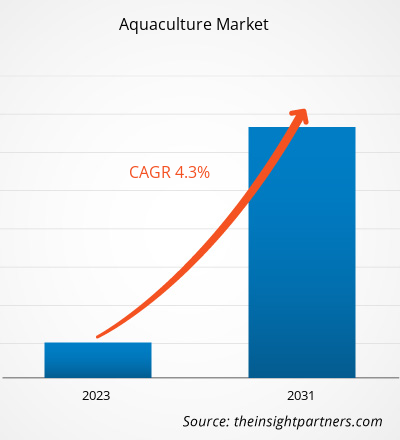全球水产养殖市场规模预计将从 2024 年的 5163.3 亿美元增至 2031 年的 7439.0 亿美元。预计 2025-2031 年期间该市场的复合年增长率 为5.4%。
全球水产养殖市场分析
全球对高蛋白食品的需求不断增长、野生鱼类过度捕捞以及水产养殖技术的进步推动着水产养殖市场的发展。随着可持续性成为关注的焦点,水产养殖业提供了一个以较低环境影响满足海产品需求的机会。循环水养殖系统 ( RAS ) 等创新技术和改良的养殖技术提高了产量和效率。此外,新兴经济体不断增加的投资和政府的优惠政策为水产养殖业的发展创造了良好的发展前景,使其成为未来粮食安全的重要贡献者。
全球水产养殖市场概览
全球水产养殖市场正经历强劲增长,这得益于海产品需求的不断增长、过度捕捞的担忧以及养殖技术的进步。预计到2024年,该市场规模将超过3000亿美元,并将继续稳步扩张,这得益于高蛋白饮食消费的不断增长以及可持续养殖方式的推行。亚太地区在该行业占据主导地位,中国是最大的生产国。关键环节包括淡水、海水和咸水养殖,重点养殖鲑鱼、虾和罗非鱼等鱼类。饲料、病害控制和鱼菜共生技术的创新进一步提高了生产力,使水产养殖成为全球粮食安全和经济发展的重要组成部分。
您可以免费定制任何报告,包括本报告的部分内容、国家级分析、Excel 数据包,以及为初创企业和大学提供优惠和折扣
水产养殖市场:战略洞察

- 获取此报告的顶级关键市场趋势。此免费样品将包括数据分析,从市场趋势到估计和预测。
全球水产养殖市场驱动因素和机遇
市场驱动因素:
全球海鲜需求不断增长
人口的增长和健康饮食观念的转变推动了海鲜消费的增长。野生渔业的过度开发
野生鱼类资源的减少正在加速全球向可持续水产养殖的转变。技术进步
育种、水质管理和疾病控制方面的创新提高了产量。政府支持与补贴
许多国家正在通过优惠政策和资金推动水产养殖业的发展。可持续和环保实践
循环水养殖系统( RAS)和综合水产养殖系统的增长。发展中地区扩张
非洲、拉丁美洲和东南亚的新兴市场具有尚未开发的潜力。
市场机会:
扩大可持续水产养殖系统
循环水养殖系统 (RAS) 和综合多营养水产养殖 (IMTA) 等生态友好型方法的增长。植物性饲料和替代饲料需求增加
利用藻类、昆虫或大豆饲料来减少对环境的影响和饲料成本功能性和有机海鲜的增长
消费者对有机、无抗生素和增值海鲜产品的兴趣日益浓厚。新兴市场的发展
非洲、东南亚和拉丁美洲的投资和基础设施不断增加。商业和酒店业的增长
酒店、餐馆和食品加工行业需要严格的虫害控制,这为服务提供商提供了增长途径。
拓展新品种和新产品
高价值或新物种(如海参、观赏鱼)和海洋生物产品(如胶原蛋白、欧米伽-3)的养殖。
全球水产养殖市场报告细分分析
全球水产养殖市场被划分为不同的细分市场,以便更清晰地了解其运作方式、增长潜力和最新趋势。以下是大多数行业报告中使用的标准细分方法:
按产品类型:
鱼
使用淡水或海水系统养殖供人类食用,富含蛋白质和 Omega-3 脂肪酸。三文鱼
在冷水网箱或陆基系统中养殖,因其高市场价值和营养而备受珍视。三文鱼
幼鱼被捕获后大多进行放养或在海笼中养殖,用于制作寿司和出口市场。鳕鱼
它在寒冷的海洋环境中养殖,以其白色、片状的肉以及在鱼片和加工食品中的用途而闻名。其他的
罗非鱼和鲶鱼等鱼类被广泛养殖,以获取价格实惠、可持续的蛋白质。
水生植物
这包括用于食品、化妆品、生物燃料和药品的海藻和藻类。甲壳类动物
虾和蟹在池塘或水箱中养殖;它们在全球美食和出口贸易中颇受欢迎。贝类
牡蛎、贻贝和蛤蜊通常在绳索或海床上生长,用于食物和珍珠生产。其他的
它们包括鳗鱼、青蛙和观赏鱼;它们是为小众市场和水族馆贸易而饲养的。
按文化环境:
淡水
由于成本低且易于获取,在河流、池塘和水箱中养殖罗非鱼、鲤鱼和鲶鱼等物种被广泛使用。咸水
利用河口和沿海池塘等略咸的环境来养殖虾和虱目鱼等物种,平衡淡水和海洋特性。海水
在海洋笼子、网箱或近海农场养殖鲑鱼、金枪鱼和鲈鱼等海水物种,是高价值海鲜生产的理想选择。
按地域划分:
- 北美
- 欧洲
- 亚太地区
- 中东和非洲
- 南美洲和中美洲
预计亚太地区的水产养殖市场将迎来最快的增长。其主要驱动力是高产量、强劲的海鲜需求以及良好的养殖条件。
水产养殖市场区域洞察
Insight Partners 的分析师已详尽阐述了预测期内影响水产养殖市场的区域趋势和因素。本节还讨论了北美、欧洲、亚太地区、中东和非洲以及南美和中美洲的水产养殖市场细分和地理位置。
水产养殖市场报告范围
| 报告属性 | 细节 |
|---|---|
| 2024年的市场规模 | 5163.3亿美元 |
| 2031年的市场规模 | 7439亿美元 |
| 全球复合年增长率(2025-2031) | 5.4% |
| 史料 | 2021-2023 |
| 预测期 | 2025-2031 |
| 涵盖的领域 | 按产品类型
|
| 覆盖地区和国家 | 北美
|
| 市场领导者和主要公司简介 |
|
水产养殖市场参与者密度:了解其对业务动态的影响
水产养殖市场正在快速增长,这得益于终端用户需求的不断增长,而这些需求的驱动因素包括消费者偏好的转变、技术进步以及对产品优势的认知度的提升。随着需求的增长,企业正在拓展产品线,不断创新以满足消费者需求,并抓住新兴趋势,从而进一步推动市场增长。

- 获取水产养殖市场顶级关键参与者概述
全球水产养殖市场份额地域分析
预计未来几年亚太地区将快速增长。亚太地区的新兴市场也为水产养殖供应商提供了许多尚未开发的扩张机会。
各地区水产养殖市场的增长情况各不相同。这源于诸多因素,例如全球海产品需求增长、野生鱼类资源枯竭、养殖技术进步、政府政策和补贴、健康意识增强和蛋白质消费增加、发展中地区扩张以及可持续环保实践的采用。以下是各地区市场份额和趋势的总结:
1. 北美
市场份额:
随着对可持续实践的投资不断增加,份额适中关键驱动因素:
- 对高品质、可追溯海鲜的需求
- 循环水养殖系统(RAS)的技术创新
- 支持性政府法规和认证
趋势:
陆基鲑鱼养殖和植物性饲料替代品的增长
2.欧洲
市场份额:
市场稳步增长关键驱动因素:
- 入侵物种威胁
- 公共卫生问题
- 气候变化的影响
趋势:
环保型生物农药和智能害虫防治的兴起
3. 亚太地区
市场份额:
最大的市场,产量占全球主导地位关键驱动因素:
- 大量食用海鲜
- 政府对水产养殖的补贴和投资
- 沿海水产养殖发展
趋势:
集约化养鱼、整合数字技术、更加注重出口导向型生产
4.中东和非洲
市场份额:
具有高增长潜力的新兴市场关键驱动因素:
- 水资源短缺推动可持续实践
- 粮食安全倡议
- 政府对水产养殖基础设施的投资
趋势:
在海洋环境中采用沙漠水产养殖和网箱养殖
5.南美洲和中美洲
市场份额:
很大一部分源于健康意识关键驱动因素:
- 富含蛋白质的饮食需求不断增长
- 扩大沿海和内陆鱼类养殖
- 政府对出口导向型水产养殖的支持
趋势:
采用可持续水产养殖实践,发展罗非鱼和虾类养殖,增加对抗病品种的投资
全球水产养殖市场参与者密度:了解其对商业动态的影响
市场密度高,竞争激烈
由于 JBS SA、Mowi ASA、Blue Ridge Aquaculture Inc 和 Thai Union Group PCL 等知名企业的加入,竞争异常激烈。Bakkafrost、Danish Salmon 和 Mowi ASA 等区域性和利基供应商也加剧了不同地区的竞争格局。
这种激烈的竞争促使公司通过提供以下产品脱颖而出:
- 循环水养殖系统(RAS)的使用
- 基于人工智能和物联网的监控和自动化
- 遗传改良和育种技术
机遇与战略举措
- 可持续和环保的实践。
- 高价值物种多样化。
- 专注于循环水产养殖系统(RAS)
- 即食或增值海鲜的介绍
在全球水产养殖市场运营的主要公司有:
- JBS公司
- 莫维股份有限公司
- 蓝岭水产养殖公司
- 泰国联合集团
- 巴卡弗罗斯特
- 库克水产养殖公司
- 丹麦三文鱼
- Leroy海鲜集团
- 斯托尔特尼尔森有限公司
- Cermaq集团
免责声明:以上列出的公司没有按照任何特定顺序排列。
研究过程中分析的其他公司:
- 格里格海鲜公司
- 萨尔玛公司
- Nireus水产养殖有限公司
- 嘉吉水产营养
- 丸叶日郎株式会社
- 日本水产株式会社 (Nissui)
- 优尼玛集团
- 美国鲍鱼养殖场
- 法拉隆水产养殖公司
- 智利水产公司
- 多出口食品
- 国际海洋观察有限公司
- 塞隆达水产养殖公司
- 三叉戟海鲜
- 新佩斯卡诺瓦集团
- 休恩水产养殖集团
- 海洋水产养殖公司
- Aqua.cl
- 德克萨斯州水产养殖公司
- 国际鱼类养殖控股公司(Asmak)
全球水产养殖市场新闻和最新发展
欧盟委员会启动全欧盟水产养殖运动
欧盟委员科斯塔斯·卡迪斯将发起一项全欧盟范围的水产养殖运动,重点提高成员国和水产养殖咨询委员会的认识和理解,旨在促进欧盟的鱼类、贝类和藻类养殖。印度与马尔代夫签署谅解备忘录,加强渔业和水产养殖合作
印度与马尔代夫签署了一份谅解备忘录,旨在加强两国在渔业和水产养殖领域的双边合作,这标志着两国朝着可持续海洋资源开发迈出了重要一步。该协议是在印度总理纳伦德拉·莫迪对马尔代夫进行国事访问期间正式签署的。巴西渔业和CAT在巴西推出首条基因编辑罗非鱼
巴西鱼类和水产养殖技术中心(CAT)在巴西开发了首条基因编辑罗非鱼,旨在通过将养殖周期从20年缩短至1年来提高生产力和产量。该项目涉及生殖诱导和体外受精测试,从而提高生长、产量和饲料效率。首批基因编辑鱼现已准备好进行性能和基因组评估。
全球水产养殖市场报告范围和交付成果
《全球水产养殖市场规模和预测(2021-2031)》报告对市场进行了详细分析,涵盖以下领域:
- 全球水产养殖市场规模以及涵盖范围之内所有主要细分市场的全球、区域和国家层面的预测
- 全球水产养殖市场趋势以及市场动态,如驱动因素、限制因素和关键机遇
- 详细的波特和 SWOT 分析
- 全球水产养殖市场分析涵盖主要市场趋势、全球和区域框架、主要参与者、法规和最新市场发展
- 行业格局和竞争分析,涵盖市场集中度、热图分析、知名参与者以及全球水产养殖市场的最新发展
- 详细的公司简介
- 历史分析(2 年)、基准年、预测(7 年)及复合年增长率
- PEST和SWOT分析
- 市场规模、价值/数量 - 全球、区域、国家
- 行业和竞争格局
- Excel 数据集
近期报告
客户评价
购买理由
- 明智的决策
- 了解市场动态
- 竞争分析
- 客户洞察
- 市场预测
- 风险规避
- 战略规划
- 投资论证
- 识别新兴市场
- 优化营销策略
- 提升运营效率
- 顺应监管趋势




















 获取免费样品 - 水产养殖市场
获取免费样品 - 水产养殖市场